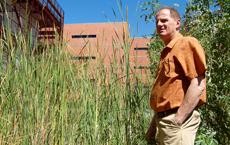The School of Landscape Architecture has created an innovative desert landscape that is both beautiful and sustainable.
The Underwood Family Sonoran Landscaping Lab is home to five different desert habitats as well as a pond that is supported completely by reclaimed water that serves as a home to the endangered fish the Gila chub, said Ron Stoltz, director of the School of Landscape Architecture.
“”(Sustainability) is the … primary goal when starting any project,”” said Todd Briggs, one of the primary architects from Ten Eyck Landscape Architects who worked on the garden.
Stoltz said there are four objectives for the Underwood Family garden. The first of these is water conservation, a particularly important concept in the desert, he said.
“”(The goal is) using water as many times as we possibly can,”” Stoltz said.
They also try as use as little potable, or drinkable, water as possible, he said. The school harvests water from rain and roof runoff.
They also collect HVAC – heating, ventilation, and air conditioning – condensation, Stoltz said. The excess water from the drinking fountains is reused as well. It goes from the sand filters into the pond.
The two to three hundred gallons of water that would usually go into the sewers stays in the landscaping around the building instead, he said. They also flush out ground well water into the pond about five times a week.
“”Some people think the pond is kind of scummy looking, but that’s just perfect water,”” Stoltz said.
The goal with a pond, besides reusing water, is to have ideal water chemistry, he said. The top several inches of the water are allowed to touch the soil, so it becomes nutrient rich. This is why they are able to support the endangered Gila chub.
“”Desert fish are very smart, they know not to get washed away,”” Stoltz said, referring to the rainy season when the pond can overflow into the entire landscape from all the roof runoff and harvested water.
The second goal of the project is to reduce the urban heat island effect, he said. The urban heat island is the effect that the concrete, brick, and asphalt creates by absorbing heat from the sun during the day and preventing the city from cooling off at night by re-releasing the heat. Stoltz said the difference between urban and rural areas can be up to 20 degrees during the summer.
To reduce this effect, the Underwood Family Garden tries to use shade to cover sidewalks and concrete areas.
There is also a green wall on one side of the building. Wild orchid vines native to Sonora, Mexico were planted along the south wall. The vines were expected to reach only about 20 feet, but have already reached the top of the building at 52 feet. Stoltz said the orchids will now start to grow outwards and should cover the whole wall in five years.
The third objective is to reduce urban flooding. By breaking up concrete washes into dirt and creating turbulence for the water, it slows the running water down and allows it to soak into the ground. This not only provides more moisture to the dry desert, but it also helps prevent rivers from flooding, Stoltz said.
The final goal of the Underwood Family Garden is to educate.
“”Because it is a learning and teaching garden, we wanted to … take the opportunity to introduce different communities,”” Briggs said.
Not only the landscaping students learn from the techniques employed in the garden. The garden is also made to scale, so people can use it as a model for their own homes, Stoltz said.
“”We want people to look at it and think, ‘Oh yeah, I could do that at my house,'”” Stoltz said. “”It’s quite comprehensible.””
The funds for the Underwood Family Garden were all donated, he said.
“”That’s a real tribute to the green industry and the Underwood family,”” he said. “”The nice thing about the project was, that since it was donated, they couldn’t take it away.””









